Any Portugal itinerary would not be complete without a stay in Lisbon. Enjoy UNESCO World Heritage sites, rich history, and beautiful beaches all from the comfort of one of central Portugal’s main cities. This popular spot on the west coast is one of Portugal’s most beautiful places. Even in the high season for summer vacationers, the warm weather lets the brisk water of the Atlantic Ocean cool you down during a day trip to Cascais.
Lisbon is a perfect place to call home during a stay in this small country. Whether you want to appreciate the great views of the city from the Santa Justa Lift or the Sao Jorge Castle you can do it in Lisbon. Take in Belem Tower and the Jernimos Monastery, two UNESCO World Heritage sites worth visiting. Popular destinations such as Sintra and Coimbra are good options for an easy day trip. Let our ultimate Lisbon itinerary inspire your own Portuguese adventure!
Get Your Travel Goals Newsletter & BONUS Workbook
Table of Contents
How Long To Stay In Lisbon
We spent six nights and five days in Lisbon. For us, this more relaxed pace and the luxury of returning to spots we felt deserved a second look was the best way to enjoy the city. But you could get away with 3 – 4 days if you’ve got a tighter time frame.
How To Get Around Lisbon
It’s not worth it to rent a car if you are focused on Lisbon itself. Parking is not always available, streets are narrow, and public transportation (e.g., metro, trains, funiculars, and trams), as well as ride-share programs, are affordable and readily available. Plan on grabbing a train or private tour that includes transportation for day trips to smaller towns such as Cascais, Sintra, or Estoril.
Train travel is a great way to day trip from your home base of Lisbon. The train station to Sintra is Rossio station and the rail service to Cascais and Estoril is served by Cais do Sodre station.
Lisbon Itinerary
Our host arranged for airport pickup and transportation to our AirBnB in the Graca area, just at the edge of the Alfama neighborhood. We found out from our driver we’d come just in time for the Santo Antonio Festival (the festival typically hits around June 12th). This is a giant street party filled with live music, amazing food from local vendors, and celebrations across the city’s most popular neighborhoods celebrating one of Lisbon’s most revered saints. Our driver suggested we rest up, and do a small amount of exploring in the area then to save up our energy because by that night streets would be swarming with parades, block parties, live music, and food booths.
For two days we explored the area and enjoyed the festival. A tin of sardines as a souvenir will cost you 15 euros in Chiado but you can grab freshly grilled sardines from anyone of the hundreds of vendors for 1.50. Coupled with a 4-euro mojito and you’ve got a pretty good snack! Not into fish, then try a bifana, a Portuguese pork sandwich. Sweet churros or farturas, the churro’s much larger and calorie-intense older brother, make for a great dessert.
Get Your Travel Goals Newsletter & BONUS Workbook
If you are going to visit Lisbon during this week in June we highly recommend you plan for at least two days to just enjoy the evenings at the different street parties.
Exploring The Historic Alfama District
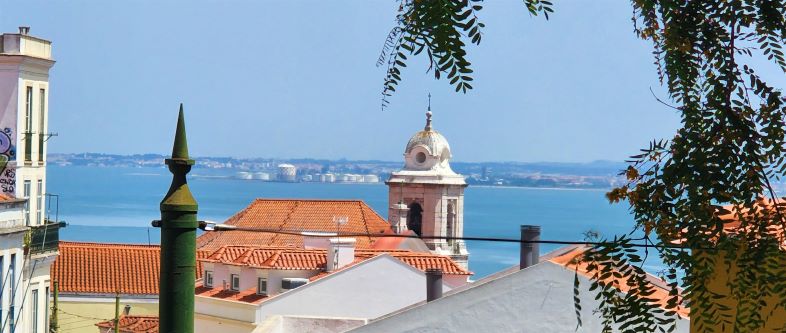
When we asked our youngest son what he wanted to see in the city he wanted to better understand the history of Portugal. We took a trip to Museo do Alijube – Resistencia e Liberdade in the historic Alfama district. During darker times, the building used to be a prison. Floors 1 and 2 currently cover the history of the dictator, Antonio Salazar as well as the resulting resistance. Ever wondered where Rowling got the name for the evil founding father of Hogwarts? She worked as an English teacher in Portugal from 1991 – 1993 and began her work on the books while staying there.

The 3rd floor covers the anti-colonization period and the eventual overthrow of the dictatorship on April 25, 1974. It was a fantastic and immersive experience that allowed the whole family to get a bit of context into why Portugal stands out among the other European countries. It was amazing to realize that anyone my age or my husband’s age would have spent their early childhood under this dictatorship. Realizing the lingering impacts of the grip of dictatorship on a still-healing country can definitely increase your perspective.

Exiting the museum you are right next to the Lisbon Cathedral. By chance, we were lucky to witness another Festival of Santo Antonio tradition as 11 couples exited the chappel after getting married together. This ceremony is sponsored by city partners and since the late 1950s was designed to give cash-strapped couples an opportunity to get married without spending too much money. The ceremony is televised to hundreds of admirers who line up the street for blocks pressed against blockades waiting alongside a live band, reporters, and camera crews to celebrate the couples as they exit the mid-12th century cathedral. After a brief celebration and interviews, and a happy explosion of white and pink confetti, the couples parade through the streets of Lisbon continuing the celebration with the city.

Enjoy the 11th-century Sao Jorge Castle! Originally built by Moors, the crusading Afonso Henriques took the castle in the mid-12th century. After buying your ticket (either at the ticket booth or online here – at the time of writing 5 euro for youth and 10 for adults) and walking through the turnstile, you can get a hint of its military history by walking along the walls peppered with cannons, though today you enjoy a panoramic city view rather than the threat of attacking ships. To the left, you’ll walk into the inner castle area, past a simple museum, where peacocks walk confidently with their young chicks, ignoring tourists and crying out to each other dramatically.
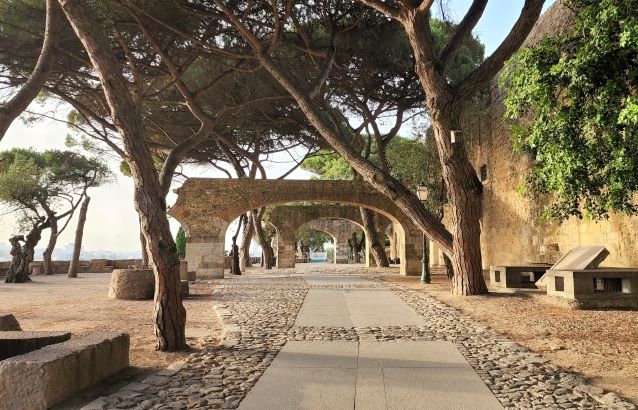
We loved climbing the castle walls and imagining the battles that raged over the centuries. Climbing to the top of one of the river-facing towers gives you a beautiful spot to enjoy a sunset.
The Alfama neighborhood is one of the oldest and most charming neighborhoods in Lisbon, and as you can tell, it offers a unique experience that sets it apart from other areas in the city. There are amazing local rentals and apartments that you can check out throughout the neighborhood.
Get Your Travel Goals Newsletter & BONUS Workbook
The Belem District
Use ride share or public transportation to get out to the Tower of Belem. This beautiful 16th-century fort was built to protect the shoreline from raiders sailing up the Tagus River. But more famously it was often the last thing sailors saw as they sailed out into the mysterious Atlantic Ocean. Granted World Heritage status by UNESCO in 1983, the tower receives hundreds of thousands of visitors a year. Based on our research, we felt it was sufficient to see the tower just from the outside but you can buy tickets for 6 euros or enter for free with the Lisboa Card.
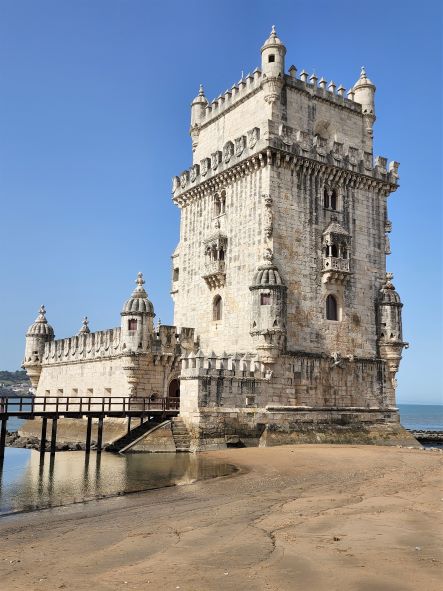
Walk toward the red suspension bridge, which looks incredibly familiar to anyone who has visited San Francisco, California. The “25th of April Bridge” which was named the Salazar Bridge until 1974, was built by the same company that built the SF – Oakland Bay Bridge and connects the city of Lisbon to Almada on the other side of the river. On the riverside promenade, you won’t be able to miss the Monument to the Discoveries. This concrete structure is shaped like the prow of a ship and stands over 160 feet tall. Built to honor the 500th anniversary of the death of Henry the Navigator, the monument also highlights Vasco de Gama, Ferdinand Magellan, Queen Philippa of Lancaster, among others. You can explore inside the building as well as take a lift up to the top for panoramic views of the area. You can get reduced admission to the museum with the Lisboa Card.

When touring this area you should not miss the Jeronimos Monastery. Just across the road from the waterfront, this remarkable building is impressive even if you aren’t someone who pays attention to Manueline architecture or Portuguese history. While the church is free to enter, you can gain easier access to the cloister by buying a 12-euro combo ticket at the Archaeology Museum. If you are relying on your Lisboa Card please recognize it does not get you out of waiting in line here. So the best bet is to grab the combo ticket and come to the cloister from the Archaeology Museum.
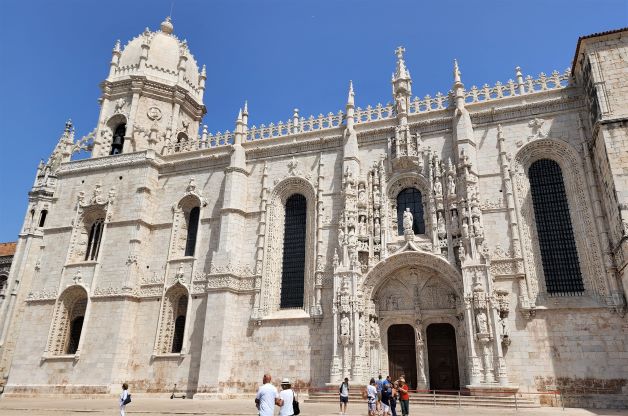
Eat at any one of the fun restaurants along the quaint avenue Rua De Belem which leads up to the monastery. Pick up a pastel de nata at the oldest bakery in Lisbon, Pasteis de Belem. People debate which bakery has the best so go ahead and try this one (strickly for comparison purposes of course). Enjoy them while you walk through the simple but enjoyable Jardim Botanico Tropical. Or you can have an Uber driver drop you off at Time Out Market for lunch as we did. It was very crowded but we appreciated all of the choices. Tip: no outside food or drink is permitted and they do have workers that come around the tables checking.
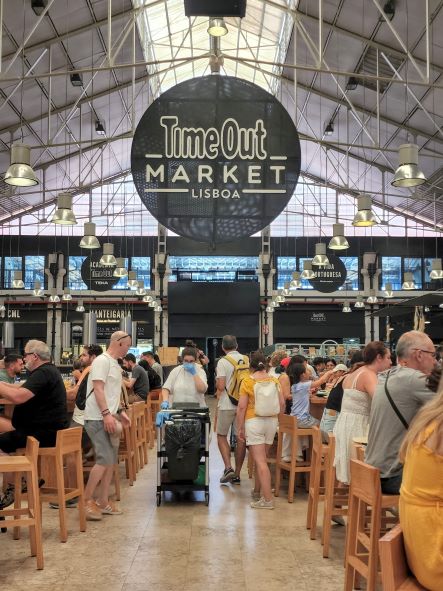
The Mouraria District
Considered an eclectic immigrant quarter of Lisbon this is where people from the many former colonies of Portugal, Mozambique, Goa, Brazil, and elsewhere came once the dictatorship ended. We chose to explore this area by walking with a private guide in order to better see areas we otherwise might not have discovered. Lucia was amazing and able to share insights on the population here as well as accommodate us on the spot as she asked us questions about what we had already explored in Lisbon, things we still had questions about, and what we’d still like to explore.
From Mozambique herself, she and her family came from the former colony after the dictatorship ended. She helped us better understand some of the exhibits we had seen at the Alijube museum. She also explained the lingering impacts of the dictatorship on today’s Lisbon and helped us interpret the street art we saw as we walked. She took us to Cantinho do Aziz to appreciate one of the best Mozambiquan restaurants in Lisbon and showed us how to interpret the landscapes we saw across the different Lisbon neighborhoods.
Get Your Travel Goals Newsletter & BONUS Workbook
Learning quickly that we had an appreciation for food and drink, she shared with us her favorite spot for ginginha, from a local vendor stationed at Praca Dom Pedro IV. And shared with us a tip for getting around the long lines at the nearby Santa Justa Lift via a nondescript set of stairs just beyond the Carmo Convent. She waited with us while we purchase tickets for the evening show, Lisbon Under the Stars, at the Carmo Convent and shared with us specific night spots to enjoy in Bario Alto (don’t miss Honorato for their amazing burgers!) then walked us just beyond the back of the convent. To the right side of the ruins, there’s a simple set of stairs. Walk up those stairs and you are at the top of the lift. All the glorious views from the top of the lift, without the long line and expense!
Tip: If you are going to see Lisbon Under the Stars, have dinner at the wonderful Grehla do Carmo. It was delicious and the most affordable meal in the area! Then you can take a short walk to Grom for gelato for dessert! So very yum!
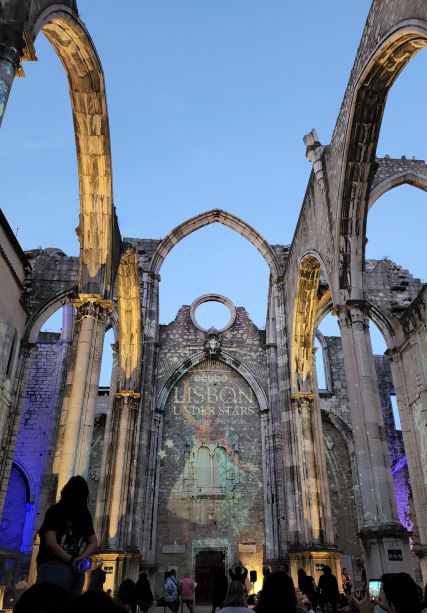
She dropped us off at the Elevador de Bica, one of the most photographed spots in all of Lisbon. Here the Bica funicular will take you up one of the steepest streets in Lisbon and you can see all the way to the Tagus River. She also recommended we return to Praca Martim Moniz to visit the recommended Cork House for quality souvenirs made locally from cork.
Lucia’s tour stayed with us and we appreciated her insight and personal touches. We highly recommend her if you are wanting a deeper understanding of Lisbon. You can reach her via WhatsApp at 00351 967101654. Send her a message to see if she can customize something that matches your interests.
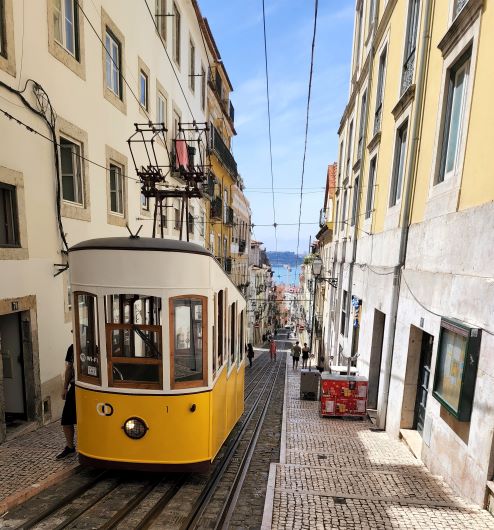
We spent the rest of the day shopping in the Chiado area and had a drink at Delirium Cafe. You can’t miss this spot with the 2nd-floor window seating and a huge pink elephant by the entrance at the top of the stairway. They have a full bar with great drinks and a ton of beers on tap.
Get Your Travel Goals Newsletter & BONUS Workbook
Parque Eduardo VII
We chose to explore the park on our last day. Named after the British King who visited in 1903, this taste of urban green is a beautiful way to wrap up your stay in the city with beautiful views of the downtown area all the way down to the river.
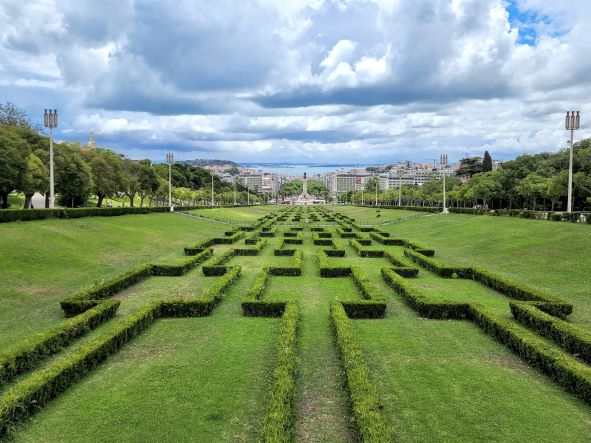
From the statue of the Marques de Pombal, you look up the slope of trimmed hedges toward the Monument and fountain dedicated to the April 25th Revolution.
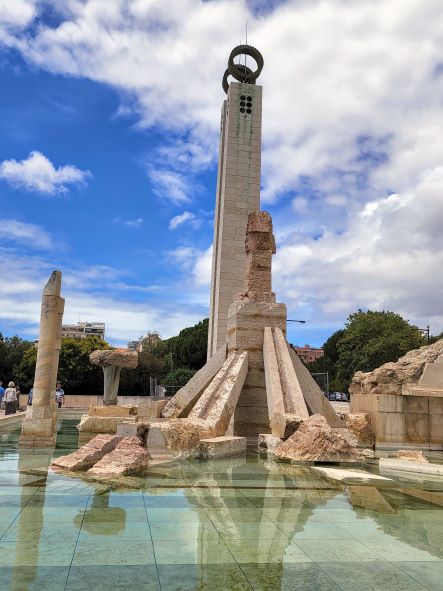
This is a beautiful place to walk and take any one of the various paths that jut off from the sides of the slope and past the monument. You can stumble across secrete gardens and small ponds with statues surrounded by ducks and geese, or cross a bridge toward a lovely outdoor dining spot.
Or continue past the park to enjoy the Museu Gulbenkian.
No matter how you choose to spend your time in Lisbon I’m sure you will appreciate the beauty here. Let us know what you are planning to do in this amazing city by leaving a comment below!
Thinking of Lisbon as a jumping-off point to elsewhere? Our post on Sao Miguel, Azores may inspire you and you can check it out here.
If you are considering other spots in Europe you can check out our posts on Italy here or Spain here.
